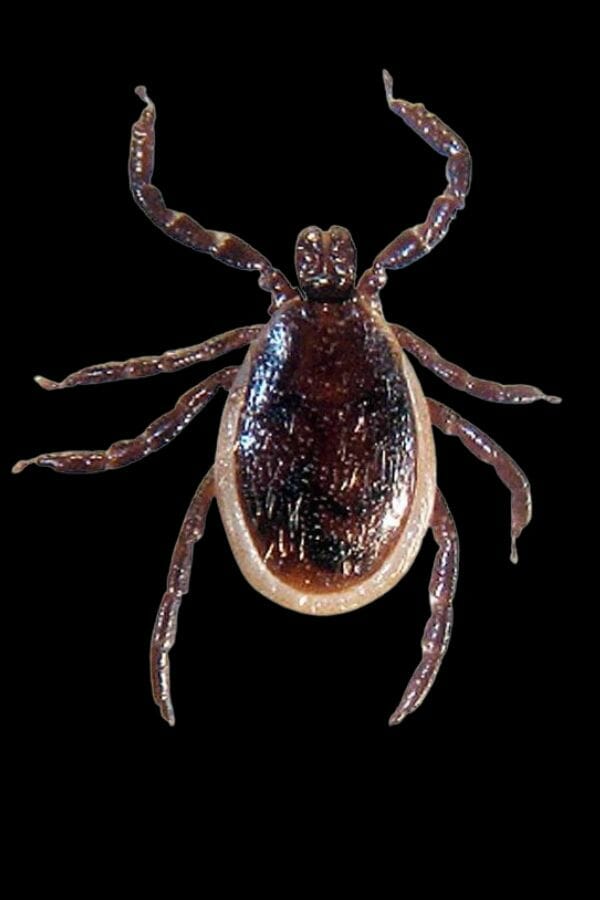

Uh oh...
It appears that you're using a severely outdated version of Safari on Windows. Many features won't work correctly, and functionality can't be guaranteed. Please try viewing this website in Edge, Mozilla, Chrome, or another modern browser. Sorry for any inconvenience this may have caused!
Read More about this safari issue.

Unfortunately, ticks are a part of life in Arkansas. And since May is National Lyme Disease Awareness Month, it’s a great time to explore these tiny creatures that can cause big problems.

Despite claims that it is “tick season,” ticks are found in Arkansas all 12 months of the year. Arkansas is home to at least five species. Each species has variations in their peak times, preferred hosts, preferred habits and diseases they can spread.

American Dog Ticks
The American dog tick is usually found in open, grassy areas like fields, the forest edge, sidewalks and trails. They prefer areas with little to no tree cover. Adults can be found from March through September, peaking from May through July. Dog ticks are named such because they prefer mid-sized animals, such as dogs, as their host. They are known to spread Rocky Mountain Spotter Fever and Tularemia.

Blacklegged Tick (Deer Tick)
More commonly referred to as the deer tick, the Blacklegged tick is found in forests and grasslands and on its preferred reproductive host, the white-tailed deer. They are active from October through June as long as daytime temperatures stay above freezing. They are known to spread Hard tick relapsing fever, Human Anaplasmosis, Human Babesiosis, Lyme disease and Powassan virus.

Brown Dog Tick
Brown dog ticks are active year-round and are mostly found around and even inside homes as well as dog kennels and animal pens. They prefer to feed on dogs and other similar-sized mammals. These ticks can spread several diseases to your pet but rarely transmit disease to humans.

Gulf Coast Tick
This species prefers grass meadows and wooded edges and is often found around cattle and deer. They are active from April to October, peaking in July and August, and can transmit Spotted Fever Rickettsiosis.

Lone Star Tick
The female Lone Star tick is easily identified by the white spot (star) in the middle of its back. These ticks favor woodland areas, especially where wild animals bed down. They are aggressive biters and will bite humans when given the chance. They can transmit Human Ehrlichiosis and Tularemia and have been associated with Alpha-gal syndrome, a disease that causes red meat allergy.
What about seed ticks?
Seed ticks are in the larval stage. When encountered, many teeny, tiny ticks can attach to the host. While not all seed ticks transmit disease, they can be the most dangerous because they often go undetected on the skin for much longer.
Tick Diseases
Tick diseases can be serious and have a significant impact on your health. Protecting yourself from ticks and watching for any signs of tick-borne illness following a bite is essential. Some common tick-borne diseases include Lyme disease and Rocky Mountain spotted fever.
Lyme Disease
Lyme disease is only spread by blacklegged (deer) ticks. When an infected tick bites, harmful bacteria are passed through its saliva. Symptoms of the disease include headache, fever, body aches and sometimes a rash. Although about 60-80% of people who contract Lyme will develop a rash, not all do, which can often lead to long-term health issues caused by Lyme going undiagnosed. Diagnosis is based on symptoms, exposure and lab work. Lyme disease is treatable with antibiotics, although some people experience long-term complications.
Rocky Mountain Spotted Fever
Rocky Mountain Spotted Fever is primarily transmitted by American dog ticks. Symptoms include a non-itchy rash on the hands, arms, feet, and legs, fever, headache, nausea, sore throat, body aches and sensitivity to light. Diagnosis is based on symptoms and exposure. Rocky Mountain spotted fever is treated with antibiotics, and symptoms usually clear up within several days. Once you have contracted Rocky Mountain spotted fever, you cannot get it again.
Alpha-Gal Syndrome
Alpha-gal is a red meat allergy that can occur following a tick bite. In the U.S., Alpha-gal is primarily caused by the Lone Star Tick. When exposed to food, such as red meat, and products that contain the alpha-gal protein, infected people may be faced with potentially life-threatening reactions. Alpha-gal is a relatively new disease and is quite rare, so not much is known about it.

Protect Yourself from Ticks
Fortunately, research has shown that in most cases, ticks must be attached for 24-36 hours for tick-borne diseases to be transmitted. Prevention and proper aftercare of bites are essential in Arkansas.
If you’re spending time outdoors in areas where they are prevalent, be sure to wear long sleeves and pants, use insect repellent, and check yourself and your pets regularly. If you do experience symptoms of a tick-borne illness, seek medical attention right away to get the treatment you need.
Follow these steps to protect yourself.
1. Be aware.
In Arkansas, ticks are active most of the year. Blacklegged (deer) ticks, which transmit Lyme disease, are active as long as the temperature stays above freezing. Anytime you are outdoors, you have the potential to encounter them.
Ticks cannot jump or fly, but they can climb, crawl or fall onto you. They can also hitch a ride on pets, including pets that have been treated for ticks.
2. Use tick repellent and dress appropriately.
Insect repellant, which contains deet, is your best defense. Products with permethrin can be used to treat shoes and clothing.
When possible, wear long pants and long sleeves. Tuck your pants into your socks. Spray your clothing with insect repellent according to the manufacturer’s instructions.
3. Check yourself (and your family members).
Complete a quick visual check for ticks any time you have spent time outdoors. Remove exposed clothing and place it in the dryer for 10 minutes to kill any ticks.
If you have children, help them check for ticks, especially in their hair. If you have a partner, check each other. (Where are all the Brad Paisley fans?)
4. Remove them properly.
Ticks should always be removed with tweezers or a tick remover. Pull straight and do not twist. Never soak a tick with essential oils, soap or petroleum jelly to force it to remove itself. This can suffocate it, causing it to regurgitate bacteria-laden saliva and can increase your risk of disease.
Save any ticks you removed between two pieces of transparent tape to help your healthcare provider with identification should you need treatment for any illness.
5. Know the signs and symptoms of tick disease.
After removing a tick, washing the area with hot soapy water and rubbing alcohol is a great first step toward preventing disease. Watch for signs and symptoms of tick-borne disease in the next few days and weeks. Fever, headache, nausea and rash, especially around the bite, are common signs to watch for.
If you suspect you may have a tick-borne illness, see a healthcare professional as soon as possible, as early treatment can mean reduced symptoms and complications.
Do you find bugs fascinating? Check out these “buggy” reads.
Lighting Bugs in Arkansas
American Burying Beetle in Arkansas
Dragonflies and Damselflies in Arkansas
Butterflies in Arkansas
Don’t Move Firewood! Protect Trees from the EAB
We do the work.
You check your email.
Sign up for our weekly e-news.
Get stories sent straight to your inbox!












 Leave a Reply
Leave a Reply
The lone star tick appears to be the same photograph as the American dog tick?
Thanks for letting us know! We fixed it.